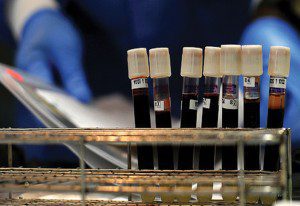By John Sylvester, M.D.
 There has been a great deal of attention in the media recently about PSA screening. A few months ago, the United States Preventative Services Task Force (USPSTF) came out with preliminary recommendations that PSA screening should not be done. They have now decided to make this decision final. They recommend no routine PSA blood tests for prostate cancer screening. These recommendations may lead Medicare and private insurance companies to refuse to pay for PSA tests.
There has been a great deal of attention in the media recently about PSA screening. A few months ago, the United States Preventative Services Task Force (USPSTF) came out with preliminary recommendations that PSA screening should not be done. They have now decided to make this decision final. They recommend no routine PSA blood tests for prostate cancer screening. These recommendations may lead Medicare and private insurance companies to refuse to pay for PSA tests.
Many prostate cancer experts were surprised and frankly upset by the USPSTF recommendations. We feel the USPSTF made some major errors. They made these recommendations after reviewing several articles published in the medical literature. They primarily based their decision on one article published in the New England Journal of Medicine (NEJM) in 2009 “Mortality Results from a Randomized Prostate-Cancer Screening Trial” (the PLCO trial). This paper evaluated whether patients randomized to PSA screening versus “usual care” experienced a reduced risk of death from prostate cancer. It was a poorly run study with major flaws and should not have been used to make any recommendations.
Problems with PLCO Article:
– Only 85% of men in PSA screening arm actually got PSA tests
– At least 52% of men in non-screening arm received PSA screening
– Length of follow-up was too short to show a survival advantage
– PSA cut-off was too high to detect many cancers when they are most curable
Why the USPSTF chose to ignore these major problems was not explained. Moreover, the USPSTF chose to ignore the positive findings in the PLCO study. The “healthy” men who participated in the PLCO were 44% less likely to die of prostate cancer with screening. The 10% of men in the study that had 1-2 PSA checks prior to entering the PLCO trial had a 25% reduction in prostate cancer deaths.
Positive Studies
Other, cleaner randomized studies have been published on PSA screening. The European randomized study from the same issue of the NEJM as the PLCO study was much larger, had less contamination and showed a 20% reduction in prostate cancer deaths initially, and with longer follow-up now shows a 31% reduction in prostate cancer deaths with PSA screening. The smaller but even better run Goteborg randomized trial showed a 44% reduction in prostate cancer deaths with PSA screening (Lancet 2010). Why the USPSTF chose to de-emphasize these positive studies was, again, not explained.
During the PSA era, prostate cancer mortality in the USA has dropped ~40%, and the percentage of men being diagnosed with metastatic (incurable disease) has dropped ~75%. The USPSTF suggests evaluation and biopsies be considered when men develop symptoms of prostate cancer. Every cancer doctor knows it is usually incurable at that point. But, the USPTF had no cancer doctors on the panel.
PSA Blood Test
The PSA blood test is simply another piece of information a doctor can discuss with his/her patient. Having a rise in PSA does not necessarily mean you need a biopsy. A short course of antibiotics may make the PSA fall, in which case a biopsy may not be needed.
Even if a biopsy is done and found to be positive for cancer, many options are available to the individual patient. These options include active surveillance, Radical Prostatectomy, Image Guided Intensity Modulated Radiation Therapy (IG-IMRT), Radioactive seed implantation (brachytherapy), hormonal manipulation, Cyrotherapy, etc. If a relatively healthy man is found to have an aggressive cancer, treatment is indicated. If an older less healthy man is found to have a low volume low risk cancer, active surveillance may be the best option. These treatment decisions are best decided by the patient and his physician, not by some government panel that did not even include any prostate cancer doctors.
Less Aggressive Therapy with Screening Detected Cancers
The USPSTF recommended against screening mammography a few years ago for women aged 40-49. This recommendation has subsequently been proven wrong. In Radiology, 2012;262:797-806, Judith Malmgren from the University of Washington in Seattle published that women age 40-49 with screening mammographically detected breast cancer have a lower cancer recurrence rate and require less aggressive therapy than women whose cancer was not detected with screening mammography. The USPSTF has a questionable track record. In men with PSA detected prostate cancer, we can often treat with less aggressive therapy which results in fewer side effects. If not diagnosed until cancer is more advanced, the side effects are worse and the cure rate is lower.
Breaking News (Reported in AMA Wire)
Eliminating prostate-specific antigen (PSA) testing for prostate cancer could result in three times more men with advanced prostate cancer, according to new research published last week in the journal Cancer. They predict metastatic prostate cancer will rise from the current level of 8,000 new cases per year to 25,000 a year if PSA screening is abandoned.
The Bottom Line
While the PSA blood test is not perfect, it is much more sensitive than the digital rectal exam alone in detecting prostate cancer at a stage when it is still potentially curable. PSA screening saves the lives of thousands of men every year. Radical prostatectomy, external beam radiation therapy (IG-IMRT) and brachytherapy (seed implantation) continue to improve. Side effects are falling and cure rates rising.
For example, in the medical journal Cancer in 2011, I published a 99.1% cancer-free survival rate with brachytherapy +/- IMRT. Other experts are publishing similar numbers. We are making major strides in beating this disease. The USPSTF recommendations must be rejected; otherwise we could be put back to where we were 30 years ago. Now that USPSTF has made its final recommendation, it is time to contact your Congressman and Senator and demand that PSA screening continue to be funded.
To learn more or to schedule an appointment, please contact Lakewood Ranch Oncology Center at 941-907-9053 or visit us online at www.LWROncology.com.
Dr. John Sylvester
Dr John Sylvester is A Radiation Oncologist with 21st Century Oncology in Bradenton/Sarasota, FL. Previously he was co-founder and Director of The Seattle Prostate Institute and Director of the Puget Sound Tumor Institute. He has published over 70 articles in medical journals on prostate cancer, and multiple medical textbook chapters. He is lead investigator in multiple prostate cancer trials. He co-wrote the American Brachytherapy Society Prostate Cancer treatment guidelines and The Prostate Cancer Treatment Book. He is a member of the American Brachytherapy Society (ABS), The American Society of Therapeutic Radiation Oncology (ASTRO), The AMA, The Florida State Medical Society, and the American College of Radiation Oncology.
Dr. John Sylvester completed both his Medical Degree and specialty training in Radiation Oncology at UCLA. He is board certified in Radiation Oncology by the American Board of Radiology. He was awarded the American Cancer Society Fellowship during his year as chief resident at UCLA. He began performing prostate brachytherapy with Dr. Blasko in 1987, and joined the Seattle team full time in 1988. Dr. Sylvester co-founded the Seattle Prostate Institute and served as the Director of Education and Training for 8 years. He ran the internationally renowned monthly program which trained more physicians in prostate cancer treatment than any other program in the world, and the highly regarded Annual Seattle Advanced Prostate Brachytherapy Conference. Dr. Sylvester was the Director of the Seattle Prostate Institute from 2006-2008. He was in charge of the ABS Fellowship rotation at the Seattle Prostate Institute, a highly competitive and desired Fellowship program for residents in Radiation Oncology throughout North America. These programs trained the lead genitourinary Radiation Oncologists at UCSF, Harvard, MDAH, UCLA, Univ. Chicago, Emory, Rush, Cleveland Clinic, Wake Forrest, Duke, Princess Margaret, British Columbia Cancer Agency, virtually all of the prostate brachytherapy programs in Australia, New Zealand, England, and South America. Until his move to Florida in 2010, he was the Chief Medical Officer of Proqura, an organization developed by the Seattle team, focused on improving the quality of permanent prostate brachytherapy throughout the world.
Over the past 2 decades, Dr. Sylvester has performed over 3700 prostate brachytherapy procedures. He has developed, and assisted in the development, of several technical improvements in the prostate cancer treatments including:
– How to better visualize the urethra during the procedure.
– How to optimally utilize R.A.P.I.D. strand.
– He was the first physician in the U.S. to use I125 Echo Seed, a more visible (on ultrasound) radioactive seed.
– He was the lead Seattle investigator in a gene therapy protocol for salvage of external beam radiation therapy failures.
– He initiated the image-guided intensity modulated radiation therapy (IG-IMRT) approach used at the Swedish Cancer Institutes’ Radiation Oncology centers, for more precise Intensity Modulated Radiation Therapy (IMRT) for prostate cancer.
– He treated the first patient in the world with the first commercially available Calypso 4-D real-time image guidance unit for prostate cancer IMRT.
– He co-authored the white paper on Calypso 4-D IG-IMRT.
– He worked with Oncura/General Electric to help create THINStrand, a new seed that is 42% thinner than standard sized seeds (less trauma) and is the first physician to use that new seed.
– He is the lead investigator in a multi-institutional protocol evaluating the quality of life outcomes of patients treated with IMRT plus a Cesium seed implant boost.
– Dr. Sylvester worked with the lead Brachytherapists at MDAH and Princess Margaret Hospital on an updated brachytherapy outcomes nomogram evaluation that invalidated inaccurate the MSKCC brachytherapy nomogram..
– He is the first physician in the USA to use SpaceOAR in IG-IMRT prostate cancer patients as part of a randomized FDA protocol hoping to reduce side effects of treatment.
– He is one of the four clinicians who wrote the ABS guidelines used by prostate cancer radiation oncologists worldwide.
The above work has led Dr. Sylvester to being called upon to present at national and international conferences on prostate cancer on a regular basis including: the World Congress of Endourology (Holland), American Society of Clinical Oncology, Urologic Society of Australasia (Melbourne), and European Association of Urology Conference in Germany, GEC-ESTRO/WCB conferences in Europe, and multiple times at the Annual American Society of Therapeutic Radiation Oncology (ASTRO) Conference, the Annual ABS (American Brachytherapy Society) Conference, The Annual Scottsdale Prostate Cancer Symposium, and The Annual Seattle Prostate Institute Advanced Brachytherapy Conferences. He was chosen to debate prostate cancer treatment techniques at the 2011 ABS meeting.
Dr Sylvester recently moved to Sarasota and now is a member of 21st Century Oncology at the Lakewood Ranch Radiation Center in Bradenton, FL where he continues cutting edge research in both prostate brachytherapy and IG-IMRT.










